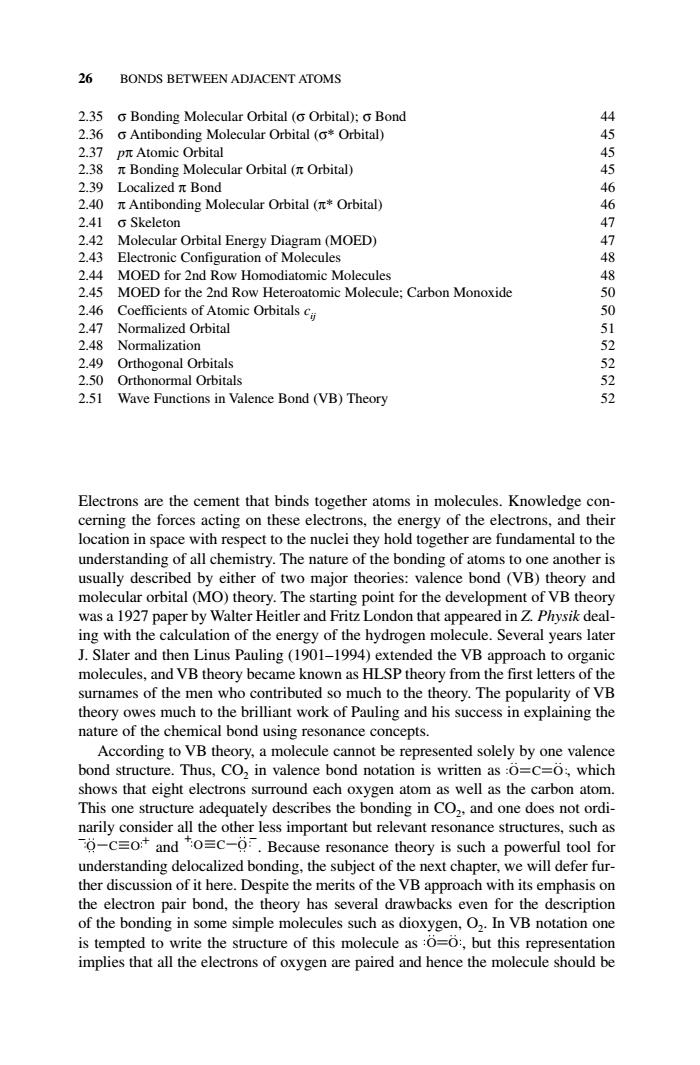正在加载图片...

26 BONDS BETWEEN ADJACENT ATOMS Bonding Molecular Orbital(Orbital):Bond o Antibonding Mo olecular Orbital (o*Orbital) 238 pi Atomic Or it cular Orbital (n Orbital ng Molecular orhital (orhitaly 241 cules 244 MOED for 2nd Row Homodiatomic Molecules 2.45 MOED for the 2nd Row Heteroatomic Molecule:Carbon Monoxide 2.46 Coefficients of Atomic Orbitalsc 2.47 Normalized Orbital 2.48 Normalization 2.49 Orthogonal Orbitals 2 Orthonormal Orbitals 2.51 Wave Functions in Valence Bond(VB)Theory Electrons are the cement that binds together atoms in molecules.Knowledge con- cerning the forces acting on these electrons,the energy of the electrons,and their location in space with spect to the nucli they hold together are fundamental to the understand of all che istry .The na ng of a another is ly des o major the molecular orbital (MO)theory.The starting point for the development of VB theory was a 1927 paper by Walter Heitler and Fritz London that appeared in Z Physik deal ing with the calculation of the energy of the hydrogen molecule.Several years later J.Slater and then Linus Pauling (1901-1994)extended the VB approach to organic molecules,and VB theory became known as HLSP theory from the first letters of the sumames of the men who contributed so much to the theory.The popularity of VB y owe uch to the brilliant work of Pauling and his explaining the the ch nical bond using res ce co ncepts According to VB theory,a molecule cannot be represented solely by one valence bond structure.Thus,CO in valence bond notation is written as:o=c=o:,which shows that eight electrons surround each oxygen atom as well as the carbon atom. This one structure adequately describes the bonding in CO2,and one does not ordi- narily consider all the other less important but relevant resonance structures,such a o-c=o+and o=c-.Because resonance theory is such a powerful tool for understanding delocalized bonding the subiect of the ext ch ther discus merits of the VB ter, e will defer fur n of it here.Des ith its nphas wbac ding in some simple mole is tempted to write the structure of this molecule as:o=0:,but this representation implies that all the electrons of oxygen are paired and hence the molecule should be 2.35 σ Bonding Molecular Orbital (σ Orbital); σ Bond 44 2.36 σ Antibonding Molecular Orbital (σ* Orbital) 45 2.37 pπ Atomic Orbital 45 2.38 π Bonding Molecular Orbital (π Orbital) 45 2.39 Localized π Bond 46 2.40 π Antibonding Molecular Orbital (π* Orbital) 46 2.41 σ Skeleton 47 2.42 Molecular Orbital Energy Diagram (MOED) 47 2.43 Electronic Configuration of Molecules 48 2.44 MOED for 2nd Row Homodiatomic Molecules 48 2.45 MOED for the 2nd Row Heteroatomic Molecule; Carbon Monoxide 50 2.46 Coefficients of Atomic Orbitals cij 50 2.47 Normalized Orbital 51 2.48 Normalization 52 2.49 Orthogonal Orbitals 52 2.50 Orthonormal Orbitals 52 2.51 Wave Functions in Valence Bond (VB) Theory 52 Electrons are the cement that binds together atoms in molecules. Knowledge concerning the forces acting on these electrons, the energy of the electrons, and their location in space with respect to the nuclei they hold together are fundamental to the understanding of all chemistry. The nature of the bonding of atoms to one another is usually described by either of two major theories: valence bond (VB) theory and molecular orbital (MO) theory. The starting point for the development of VB theory was a 1927 paper by Walter Heitler and Fritz London that appeared in Z. Physik dealing with the calculation of the energy of the hydrogen molecule. Several years later J. Slater and then Linus Pauling (1901–1994) extended the VB approach to organic molecules, and VB theory became known as HLSP theory from the first letters of the surnames of the men who contributed so much to the theory. The popularity of VB theory owes much to the brilliant work of Pauling and his success in explaining the nature of the chemical bond using resonance concepts. According to VB theory, a molecule cannot be represented solely by one valence bond structure. Thus, CO2 in valence bond notation is written as , which shows that eight electrons surround each oxygen atom as well as the carbon atom. This one structure adequately describes the bonding in CO2, and one does not ordinarily consider all the other less important but relevant resonance structures, such as and . Because resonance theory is such a powerful tool for understanding delocalized bonding, the subject of the next chapter, we will defer further discussion of it here. Despite the merits of the VB approach with its emphasis on the electron pair bond, the theory has several drawbacks even for the description of the bonding in some simple molecules such as dioxygen, O2. In VB notation one is tempted to write the structure of this molecule as , but this representation implies that all the electrons of oxygen are paired and hence the molecule should be O O O C + − C O + O − O O C O 26 BONDS BETWEEN ADJACENT ATOMS c02.qxd 5/17/2005 5:13 PM Page 26